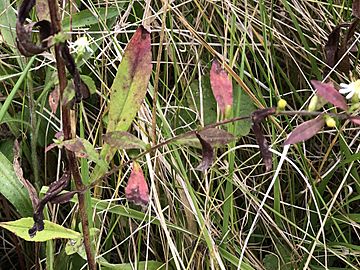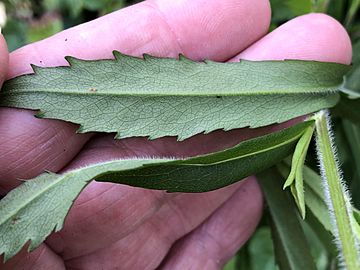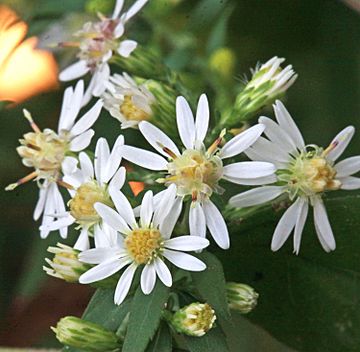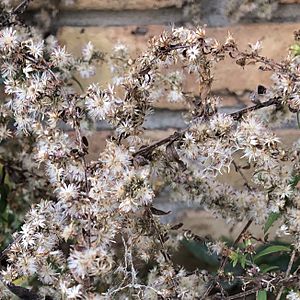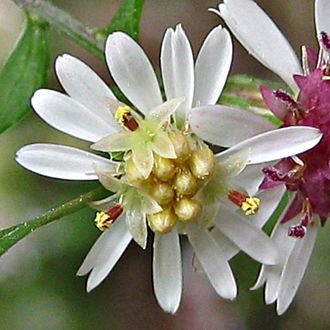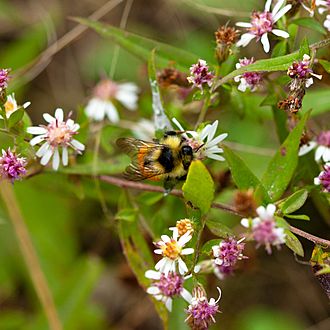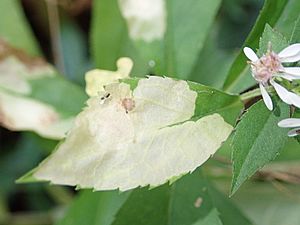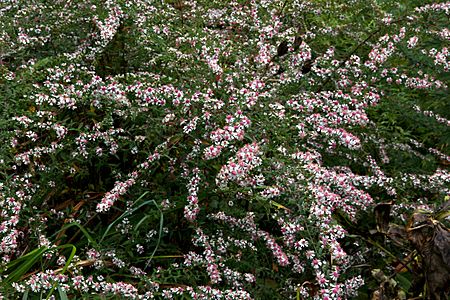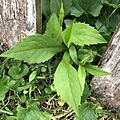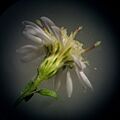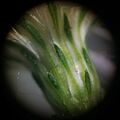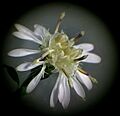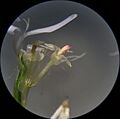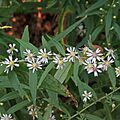Symphyotrichum lateriflorum facts for kids
Quick facts for kids Symphyotrichum lateriflorum |
|
|---|---|
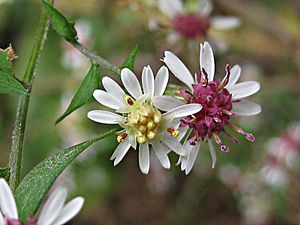 |
|
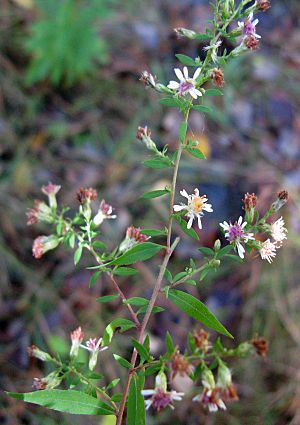 |
|
| Conservation status | |
| Scientific classification | |
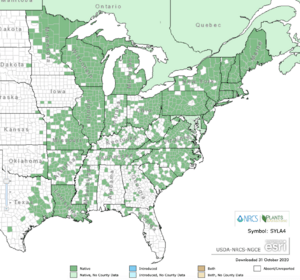 |
|
| USDA PLANTS county-level distribution map | |
| Synonyms | |
|
Basionym
Most recently
Others listed alphabetically List
Aster acadiensis Shinners
Aster agrostifolius E.S.Burgess Aster bellidiflorus var. rigidulus (Nees) DC. Aster bifrons Lindl. ex DC. Aster diffusus Dryand. ex Aiton Aster diffusus var. bifrons (Lindl. ex DC.) A.Gray Aster diffusus f. bifrons (Lindl. ex DC.) Voss Aster diffusus var. hirsuticaulis (Lindl. ex DC.) A.Gray Aster diffusus f. hirsuticaulis (Lindl. ex DC.) Voss Aster diffusus var. horizontalis (Desf.) A.Gray Aster diffusus var. variifolius Peck Aster divaricatus Raf. ex DC. Aster divergens Aiton Aster divergens var. diffusus (Aiton) Nutt. Aster divergens var. humilior DC. Aster divergens var. pendulus (Aiton) Nutt. Aster hirsuticaulis Lindl. ex DC. Aster horizontalis Desf. Aster lateriflorus var. angustifolius Wiegand Aster lateriflorus var. bifrons (Lindl. ex DC.) Fernald Aster lateriflorus var. flagellaris Shinners Aster lateriflorus var. glomerullus E.S.Burgess Aster lateriflorus var. grandis Porter Aster lateriflorus var. hirsuticaulis (Lindl. ex DC.) Porter Aster lateriflorus var. horizontalis Farw. Aster lateriflorus var. indutus Shinners Aster lateriflorus var. pendulus E.S.Burgess Aster lateriflorus var. spatelliformis (E.S.Burgess) A.G.Jones Aster lateriflorus var. tenuipes Wiegand Aster leucanthemus Raf. Aster miser Nutt. Aster miser var. abbreviatus DC. Aster miser var. diffusus (Aiton) L.C.Beck Aster miser var. divergens (Aiton) L.C.Beck Aster miser var. glomerellus Torr. & A.Gray Aster miser var. hirsuticaulis (Lindl. ex DC.) Torr. & A.Gray Aster miser var. miserrimus Torr. & A.Gray Aster miser var. myrtifolius (Willd.) DC. Aster miser var. pendulus (Aiton) L.C.Beck Aster miser var. vimineus Farw. Aster myrtifolius Willd. Aster pendulus Aiton Aster recurvatus Günther ex Nees Aster rigidulus Nees Aster scoparius Nees Aster seliger Nees Aster spatelliformis E.S.Burgess Aster tenuipes (Wiegand) Shinners Aster tradescantii Michx. Aster vimineus var. columbianus Britton |
The Symphyotrichum lateriflorum is a beautiful flowering plant. It is part of the aster family and grows naturally in eastern and central North America. You might know it as the calico aster, starved aster, or white woodland aster. This plant is a perennial, meaning it comes back year after year. It can grow up to about 4 feet (120 cm) tall and 1 foot (30 cm) wide.
Each flower head of the calico aster looks like one flower, but it's actually made of many tiny flowers called florets. The flowers are smaller than most other Symphyotrichum species. They usually have 7 to 15 short white ray florets, which are like the petals. Sometimes, these ray florets can be a light pink or lavender color.
The center of the flower has disk florets. These start out creamy or yellow. As they get older, they often change to pink, purple, or brown. There are usually 8 to 16 disk florets. Each one has five parts that bend backward when they open. The leaves of the plant are mostly smooth. A cool thing about them is that they have a fuzzy midrib (the main vein) on their underside. The branches often grow sideways or in a zigzag pattern. The flower heads usually grow along one side of these branches.
You can find Symphyotrichum lateriflorum in many different places. It grows across most of the eastern and central United States and Canada. There's even a native group of them in Veracruz, Mexico. This plant is considered safe in terms of conservation. Its flowers appear in late summer and fall. They attract small pollinators and insects looking for nectar, like sweat bees, miner bees, and hoverflies.
Besides growing wild, Symphyotrichum lateriflorum also has many different types grown in gardens. People have been growing it in Europe for over 250 years! Some popular garden types are 'Bleke Bet', 'Lady in Black', and 'Prince'. Native Americans have also used this plant as a medicinal plant.
Contents
What's in a Name?
The scientific name lateriflorum tells us something special. It comes from Latin words meaning "side" (lateri) and "flower" (florum). This is because the flowers of this plant usually grow on one side of the branch.
People call Symphyotrichum lateriflorum by many common names. These include calico aster, starved aster, white woodland aster, side-flowering aster, and farewell summer. Sometimes, like other asters that bloom in the fall, it's called a Michaelmas Daisy.
The word Aster comes from an Ancient Greek word meaning "star." This name refers to the star-like shape of the flower. The word "aster" was used for star-shaped flowers way back in 1542. An old common name for these star-like plants is starwort.
In other languages, this plant has different names. For example, in German, it's called Waagerechte Aster, which means "horizontal aster."
Plant Description
Symphyotrichum lateriflorum is a plant that grows in clumps. It can be about 8 inches (20 cm) to 4 feet (120 cm) tall. It can spread up to 1 foot (30 cm) wide. How it looks can change during its life or throughout the year. A mature plant might have many stiff stems with arching branches and lots of flowers. A younger plant might have just one short stem with big leaves and one flower at the top.
Roots and Stems
The roots of Symphyotrichum lateriflorum have short, woody parts called caudices. They can also have short rhizomes, which are underground stems that can grow new plants.
The plant usually has one to five stems growing from its roots. These stems can be reddish, purplish, or green. The color often depends on how much sun the plant gets. Green stems are more common in shady spots.
Thin, flexible branches grow from the stems. They often grow out almost straight or in long arches. Shorter branches might grow upwards. Stems and branches can have fine, soft hairs, usually in vertical lines.
Leaves
Symphyotrichum lateriflorum has alternate leaves, meaning they grow one after another along the stem. The leaves are simple, meaning each leaf has only one blade. Leaves at the bottom of the plant are usually larger. Leaves higher up on the stem and branches get smaller. By the time the flowers bloom, the lower leaves might have dried up or fallen off.
The leaves have a network of fine veins. They are mostly smooth, except for a key feature: the main vein on the underside of the leaf (the midrib) is usually hairy. This hair might disappear as the plant gets older.
Lower and middle stem leaves are often directly attached to the stem or have very short stalks. Their shapes can vary. Leaves higher up on the stem and branches are also directly attached. Their edges are often smooth. The higher the leaves are, the smaller they become.
Flowers
Symphyotrichum lateriflorum blooms in late summer and fall. Flowers can start opening as early as July and as late as November. The flower heads grow in clusters along the upper sides of the branches. These clusters can be up to 10 inches (25 cm) long. The flower heads at the very ends of the branches open about a week before the others.
Each flower head is about 0.3 to 0.6 inches (0.8–1.6 cm) wide when it's blooming. They don't have much of a smell. At the base of each flower head are small leaf-like parts called bracts.
Flower Parts
The outside of the flower heads has small, scale-like parts called phyllaries. These phyllaries form a protective layer called an involucre around the individual flowers before they open. The involucres of Symphyotrichum lateriflorum are shaped like a cylinder or bell. They are usually about 0.16 to 0.24 inches (4–6 mm) long.
Each flower head has two types of tiny flowers: ray florets and disk florets. There are usually 7 to 15 ray florets, which are the white "petals." They are typically white, but sometimes they can be pinkish or purplish. Ray florets are female flowers. They can receive pollen and make a seed, but they don't produce pollen themselves.
The disk florets are in the center of the flower head. There are usually 8 to 16 of them. They start out cream or light yellow. After they open, they can turn pink, then purple or light brown. Each disk floret has 5 petals that open up into 5 pointed parts. These parts bend sharply backward once they are open. Disk florets are bisexual, meaning they have both male and female parts. They produce pollen and can also make a seed.
Fruit
The fruits of Symphyotrichum lateriflorum are actually called cypselae. They look like seeds but are surrounded by a special sheath. After the flowers are pollinated, these fruits mature in about 3 to 4 weeks. They become gray or tan and have a few stiff hairs on their surface. They also have a tuft of white to pinkish hairs called pappi. These pappi help the seeds float away in the wind.
Where it Grows
Native Range
Symphyotrichum lateriflorum grows naturally in many parts of North America. In the United States, you can find it in all states east of the Mississippi River. It also grows in states on the west side of the Mississippi, like Minnesota and Texas. In Canada, it's found in provinces like Ontario and Quebec. There's also a native population in Veracruz, Mexico.
Habitat
This plant can grow in many different places. It likes wet to moderately dry woodlands and savannas. You can also find it in floodplains, fens (wetlands), marshes, and wet prairies. It often grows on banks, in thickets, and along shores. It prefers sandy or gravelly soil that can be dry, damp, or even wet.
Symphyotrichum lateriflorum is listed as a wetland plant in the U.S. This means it often grows in wetlands, but it can also grow in drier areas.
It often grows near other native North American trees. These can include silver maple, common hackberry, and American elm. It also grows alongside other Symphyotrichum species, like panicled aster and New England aster.
Ecology and Life Cycle
Symphyotrichum lateriflorum is sometimes considered a weed, but it's one of the least weedy aster species in Canada. It's not listed as a harmful weed in either Canada or the United States.
Reproduction
The ray florets (the "petals") of this plant are female. They have parts to receive pollen but don't make pollen themselves. The disk florets (in the center) have both male and female parts. They produce pollen and can also make seeds.
An interesting thing about S. lateriflorum is that its flower heads "go to sleep" at night. The ray florets close around the disk florets. This might help protect the pollen inside and stop the nectar from drying out.
Pollination happens with the help of insects. Small or medium-tongued insects can move pollen from one plant to another. This is called cross-pollination. The plant needs cross-pollination to make many healthy seeds. If it pollinates itself, it only makes a few seeds.
Inside the disk floret, the pollen-making parts are joined together to form a tube. This tube surrounds the part that receives pollen. As this part grows, it collects pollen. After the pollen is carried away, the part splits open to receive pollen from another plant.
Seeds are ready about 3 to 4 weeks after pollination. Then, the wind helps spread them.
The plant can also reproduce by cloning itself using its short underground stems (rhizomes). This usually creates small groups of plants, not large colonies.
Pollinators and Nectar-Seekers
Many insects visit the flowers of Symphyotrichum lateriflorum. These include:
- Common eastern bumblebees
- European honeybees
- Yellowjackets
- Bald-faced hornets
- Miner bees
- Apoid wasps
Sweat bees and hoverflies also love these flowers. Some types include the bristle sweat bee and the golden green sweat bee.
Pests and Diseases
Some caterpillars, like the banded woolly bear, eat the leaves of the calico aster. Tiny insects called Leaf miners also feed on the leaves, creating tunnels. The larvae of certain moths feed on the seeds. Small bumps called galls can form on the plant where midge larvae develop.
Fungal diseases like rusts and powdery mildew can also affect the leaves of Symphyotrichum lateriflorum.
Conservation Status
Symphyotrichum lateriflorum is generally considered a Secure (G5) species worldwide. This means it's not at risk of disappearing. However, in some states like Kansas and Nebraska, it is Critically Imperiled (S1), meaning it's very rare there.
Uses of the Plant
Traditional Uses
Native Americans have used this plant for different purposes. The Meskwaki people used the blossoms as a "smudge" to help someone who was feeling confused. They also used the whole plant in a steam bath. The Mohawk people used this plant mixed with another aster to treat fever.
Gardening and Restoration
You can buy seeds or root parts of Symphyotrichum lateriflorum from companies that focus on native wildflowers. People use them for gardens and to help restore natural areas.
This plant is quite tough and can grow in many climates. It can handle cold temperatures down to about -40°F (-40°C). You can grow it from seeds in a sunny spot. Or, you can let the seeds stay in the garden bed over winter to sprout in spring. If you have an adult plant, you can divide its roots to make new plants every few years. It grows well in shade or sun and likes soil that has some moisture.
People have been growing Symphyotrichum lateriflorum in gardens in Europe since at least 1758. One type, called S. lateriflorum var. horizontale, even won an award in 1993 from the Royal Horticultural Society. This award means it's a great plant for gardens.
There are many different types of calico aster grown in gardens, called cultivars. Here are a few:
- Bleke Bet: This type can grow up to 4 feet (120 cm) tall. It has dark leaves and flowers with white "petals" and centers that turn rose or purple. It's good for cut flowers and attracting bees and butterflies.
- Buck's Fizz: This shorter type grows to about 1.6 feet (50 cm). It has white or light pink flowers with yellow centers that turn raspberry red.
- Chloe: This type has small, pinkish-white flowers with a darker pink center. It's also good for cut flowers and attracting bees and butterflies.
- Coombe Fishacre: This type spreads out and has dark leaves. Its flowers have lilac-pink "petals" and brownish-pink centers. It's very popular in gardens.
- Lady in Black: This type has unique bronze and dark purple leaves. Its flowers have white "petals" and rosy-pink centers. It's a bushy plant that can grow quite tall.
- Prince: This compact type stays shorter, about 1 to 2 feet (30–60 cm) tall. It has dark purple leaves and white flowers with large, deep pink centers. It's also great for attracting bees and butterflies.
Images for kids
-
Microscopic photo of the involucre of a flower head of S. lateriflorum plant showing phyllary detail. The green zone of each phyllary is shaped like a lens. The inner phyllaries are much longer and linear-shaped than the outer ones, and visible on the edges of each phyllary are white-looking translucent margins.
-
'Lady in Black' at Behnke Nurseries, Beltsville, Maryland.



